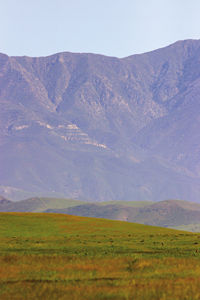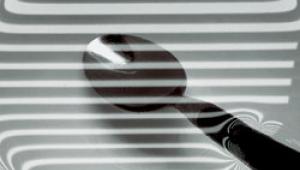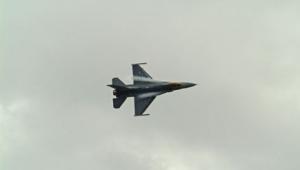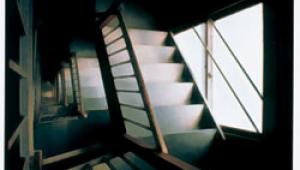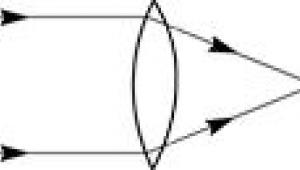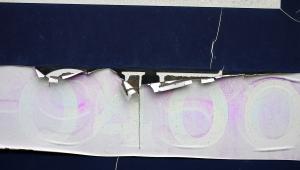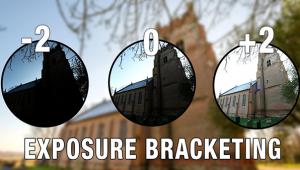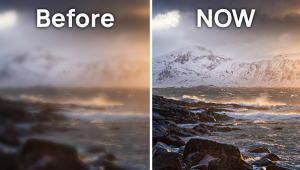The lenses that we use will define the kind of pictures that we are going to accomplish. - BentleyForbes
Choosing and Using Lenses Page 2
|
Another thing that a single curved lens element cannot do is focus parallel rays passing through its center and its edges at the same plane. Rays passing through the edges are bent more and thus focused slightly in front of rays passing through the center. This is called spherical aberration, and lens designers can correct it by employing aspherical and multiple lens elements. You can reduce it by stopping the lens down—spherical aberration is most evident at wide apertures.
Aspherical and apochromatic lenses tend to perform better than others, because they are corrected for these problems. Generally, such lenses are worth their extra cost. Even photographic lenses corrected for chromatic aberrations do not focus infrared rays on the same plane as visible rays, so when using black-and-white infrared film, you must compensate for this. To make this easy, most lens makers include infrared focusing marks on their lenses. When using black-and-white infrared film, focus in the usual manner, then rotate the lens' focusing ring so that the focused distance appears opposite the infrared focusing mark rather than opposite the normal focusing index. (In color infrared film, two of the three emulsion layers are sensitive to visible light, so it's best to focus normally rather than using the infrared focusing mark. In any infrared shooting, it's wise to stop the lens down so depth of field can help compensate for the difference in focus plane between visible and infrared rays.) The distance from the optical center of the lens to the film or digital image sensor when the lens is focused at infinity is called the focal length. Focal length is important because it determines the magnification of the image and the angle of view—how much of the scene will appear in the photograph. Longer focal length lenses produce greater magnification and narrower fields of view, while shorter focal length lenses produce less magnification and wider fields of view.
Apertures
With some cameras, the size of the aperture is controlled by the lens' aperture ring; with other cameras, apertures are set using a dial on the camera body. The aperture ring (or camera LCD panel, when apertures are set using the camera dial) is calibrated in f-numbers. F-numbers represent ratios: the ratio between the diameter of the aperture and the focal length of the lens. When the aperture is set to 4 (known as f/4), the diameter of the opening is 1/4 the focal length of the lens. With a 100mm lens, the aperture is thus 25mm in diameter when the aperture ring is set to f/4. The accompanying diagram shows the relative diameters of full-stop apertures from f/1.4 to f/16. (Many cameras and lenses permit you to set apertures in 1/2- and 1/3-stop increments; for simplicity, the diagram skips those increments and just shows full-stop increments.) Because they represent ratios, as the f-numbers go up, the diameter of the opening gets smaller and the amount of light transmitted goes down. For example, f/8 transmits half as much light as f/5.6, but twice as much light as f/11. For another example, an aperture of f/2 transmits four times as much light as f/4, because its diameter is twice that of f/4 and thus its opening is four times the area of f/4. Because the f-number system is based on the ratio between the aperture diameter and the focal length of the lens, in theory a given f-number transmits the same amount of light on any focal-length lens. For example, f/8 on a 100mm lens theoretically transmits the same amount of light as f/8 on a 1000mm lens. (Of course, f/8 on the 1000mm lens means an effective aperture diameter of 125mm, while f/8 on the 100mm lens means a diameter of 12.5mm. That's one reason why you don't see long lenses with large maximum apertures: a 500mm f/1.4 lens would need an effective aperture diameter of 357mm, or about 14 inches!) Lenses with large maximum apertures are termed "fast": an 85mm f/1.4, or the Canon's and Leica's 50mm f/1.0 lenses, for example. Lenses with small maximum apertures are considered "slow": a 50mm f/3.5 macro lens, or a 500mm f/8 mirror lens, for example. Faster lenses provide brighter viewfinder images for easier focusing, and they permit using faster shutter speeds in dimmer light, but they are also more expensive, heavier and generally not as sharp at maximum aperture. If you do a lot of low-light shooting, or long telephoto action work, a faster lens is a wise choice, budget permitting. If your budget doesn't permit getting a fast lens, you can always switch to a faster film—while faster films are grainier than slower ones, today's ISO 400 color-print films (and Fujichrome Provia 400F slide film) are excellent.
Depth of Field
Depth of field refers to the area in front of and beyond the point focused on in which objects appear sharp in the photograph. Depth of field is controlled by the lens aperture setting (smaller apertures increase depth of field, larger apertures decrease it), as well as by the shooting distance (greater distances increase depth of field) and lens focal length (depth of field is greater with shorter focal lengths). As it controls the amount of light, the aperture also controls the depth of field—the area in front of and behind the point of focus where objects appear acceptably sharp in the photograph. Small-diameter apertures (those with large numerical values, like f/22) provide greater depth of field; large-diameter apertures (those with small numerical values, like f/1.4) provide little depth of field. Many of today's 35mm SLR cameras offer a depth-of-field preview, which stops the lens down to the set aperture so you can see in the viewfinder how much depth of field you have at any aperture. But bear in mind that when you stop the lens down, it transmits less light, so the image you see in the viewfinder gets darker. At small apertures in dim light, the viewfinder image might be too dark to allow you to analyze depth of field. For example, if you have an f/2 lens and stop it down to f/16, you'll cut the light to 1/64 what it is at f/2—the viewfinder image will be 1/64 as bright. In this case, or if the camera has no depth-of-field preview, you can use the depth-of-field scale on the lens barrel to see approximately how much depth of field you have at a given f-stop and focusing distance—assuming the lens has such a scale; many newer ones don't. There are a couple of things you should keep in mind regarding depth of field. First, it's really an illusion. The point focused upon is "sharp"; as a subject moves closer or farther away, it becomes less sharp. Within depth-of-field limits, objects will appear acceptably sharp in moderate-sized prints, but for maximum sharpness, try to focus accurately. Second, lenses tend to produce the sharpest results at their middle apertures. At large apertures, various lens aberrations reduce sharpness, and at small apertures, diffraction reduces sharpness. So for sharpest results, shoot at medium apertures unless the you need a lot of depth of field, or you need the speed of a wide aperture and the resulting faster shutter speeds to shoot hand-held in dim light. Depth of field affects what appears to be in focus behind and in front of the focused subject, and should not be confused with depth of focus, which is the minute amount the film (or digital image sensor) plane can move toward or away from the lens before the circles of confusion become large enough to noticeably affect image sharpness. Today's computer-assisted lens designs and high-tech optical glasses and plastics provide us with highly corrected lenses that are amazingly sharp. But even so, they need to be focused accurately and used at their optimum apertures, and mounted on a tripod to produce optimum "blow it up to mural size" image quality—image blur due to camera shake when shooting hand-held can negate the high resolution of even the sharpest, most costly pro lens. With practice, you can get very sharp images hand-held, but they won't be the best the lens can do. |
- Log in or register to post comments






